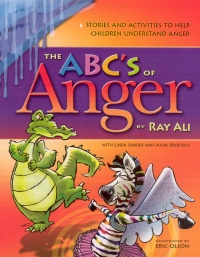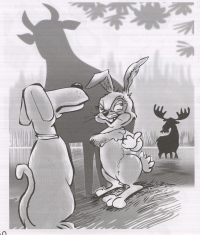| ________________
CM . . . . Volume XVI Number 5. . . .October 2, 2009. 
 |
The ABC’s of Anger.
Ray Ali with Linda Sander and Jason Kroetsch. Illustrated by Eric Olson.
Duluth, MN: Whole Person Associates (Order from rali@shaw.ca), 2006.
64 pp., pbk., $15.95 (plus postage).
ISBN 1-57025-244-0.
Subject Heading:
Anger in Children
Professional: Preschool-grade 3.
Review by Dave Jenkinson.
*½/4
|
| |
|

excerpt:
Bertha Bear has some nice qualities about her, but she also has a bad reputation for bullying other children. No wonder Bertha does not have many friends in her school. In fact, the only kids she hangs around with are those who think it is “real cool” to bully others. Bertha is very careful about who [sic] she bullies. During recess, she is never mean to big, strong kids. Instead, she likes to bully one classmate who is shy and much smaller than she is. Bertha thinks it is funny, but it is not. It has to stop!.
The old saw, “Don’t judge a book by its cover,” is certainly true of The ABC’s of Anger. When I saw its bright cover with its cartoon animals and then considered the book’s title and the additional words “Stories and activities to help children understand anger,” I assumed it was another thematic alphabet book for young children. I couldn’t have been more wrong According to the authors’ “Introduction”:
This book is a resource for early childhood teachers (preschool to grade three), providing them with a wide variety of strategies to use when planning lessons about social and emotional well-being. The book is not meant to be a student workbook, but rather a springboard for teachers to use to initiate discussion and stimulate activities that promote student reflection on the topics being covered.
Each double page spread is made up of five parts or components. The left hand page consists of a brief story (see excerpt above) that is to illustrate “some aspect of the theme ‘anger.’” The story is accompanied by one of Eric Olson’s cartoon style illustrations. The “Introduction” clarifies that “[t]hese pictures and stories may be photocopied and distributed for younger children to color and for older students to add cartoon speech bubbles.”
The recto is the teacher’s “lesson” page, and on it can be found the appropriate letter of the alphabet in upper case, the targeted “anger” word and its definition.
B
Bullying
is using your power to persistently and intentionally hurt someone weaker than you are.
Six “Discussion Starters” and two “Things To Do” are also placed on this page. Foe example, the “Discussion Starters” and “Things To Do” for “Bullying” are:
Discussion Starters
1. Close your eyes and recall the last time you saw someone being a bully.
2. What can be done to prevent yourself from being bullied?
3. What is the difference between “bully behavior” and “having fun” or “teasing”?
4. What needs are being met by someone who bullies? How can they meet those needs in a different way?
5. What can you do to keep someone from being bullied?
6. What can you do to help someone like Bertha stop bullying others?
Things To Do
Suggest that students watch their favorite TV shows and look for people who act like bullies.
Discuss with students ways to “bully proof” your classroom.
A “resource chapter” can be found at the end of the book, which, according to the authors, “further explains the theme words and provides additional questions for classroom use.”
Bully
Bullying is an increasing concern in many schools, and sadly this issue presents itself at every grade level. We are beginning to understand the signs of bullying and are becoming more aware of its impact on those affected by it – both the bullies and their victims. It is important that this issue be discussed in every classroom.
Bullying may involve physical violence, threats, extortion, teasing, humiliation, shunning, or hurtful rumors. To reduce it, try some of the following ideas:
* Identify specific situations that describe bully behaviors.
* Be familiar with the signs of bullying.
* Send a strong message that bullying is not tolerated.
* Develop strategies for bullies, for their victims, and for those who observe bullying.
* Monitor unstructured times such as recess and lunch hour as well as hallway activities.
* Involve parents in developing programs and policies to create classrooms and schools that are “bully-free zones.”
Additional questions for discussion
* What does it feel like to be bullied?
* Why do kids bully others? What do they have to gain?
* Why are some kids bullied more often than others?
* Is there a difference between how boys and girls bully?
* Why do bullies think it is okay or funny to bully others?
* How does a bully choose someone to bully?
 The book’s lead author, Ray Ali, is “a seasoned marriage and family therapist. He consults with schools and social service organizations and facilitates workshops on a wide range of topics....” His coauthors are Linda Sander, a school guidance counselor, and Jason Kroetsch, an early childhood classroom teacher. The book’s lead author, Ray Ali, is “a seasoned marriage and family therapist. He consults with schools and social service organizations and facilitates workshops on a wide range of topics....” His coauthors are Linda Sander, a school guidance counselor, and Jason Kroetsch, an early childhood classroom teacher.
Given that The ABC’s of Anger is a teacher resource and is obviously not meant to be used in an A-Z, cover-to-cover approach, why did the authors elect to constrain themselves by using the format of an alphabet book? Instead of being able to freely select words that explored aspects of “anger,” the authors had to come up with words to match the letters of the alphabet, a situation which led to the book’s featuring non-anger words like “daredevil,” “generous,” “listening,” “nutrition” and “zany.” And the authors couldn’t come up with any words for the letters V,W and X.
Having the authors’ permission to photocopy the stories and their accompanying illustrations is a positive feature of The ABC’s of Anger. However, I must seriously question the design decision to separate the teacher’s portion of each pair of facing pages from the its appropriate matching section in the resource chapter. Given that children would not have direct access to the book, there was no reason, for example, for not having all of the information and discussion questions about “Bullying” in one place rather than in two. And, while suggested discussion questions are all well and good in themselves, the discussion that takes place needs to be more than a sharing of ignorance. Someone, for instance, needs to know the answer to questions like “How does a bully choose someone to bully?” or “Is there a difference between how boys and girls bully?” and, if the authors aren’t going to provide the answers directly, then they need to identify resources where the answers can be located. The intent of The ABC’s of Anger was admirable, but its actualization is too thin in content.
Not Recommended.
Dave Jenkinson, CM’s editor, lives in Winnipeg, MB.

To comment on this title or this review, send mail to
cm@umanitoba.ca.
Copyright © the Manitoba Library Association. Reproduction for personal use is permitted only if this copyright notice is maintained. Any other reproduction is prohibited without permission.
NEXT REVIEW |
TABLE OF CONTENTS FOR THIS ISSUE- October 2, 2009.
AUTHORS |
TITLES |
MEDIA REVIEWS |
PROFILES |
BACK ISSUES |
SEARCH |
CMARCHIVE |
HOME |

 The book’s lead author, Ray Ali, is “a seasoned marriage and family therapist. He consults with schools and social service organizations and facilitates workshops on a wide range of topics....” His coauthors are Linda Sander, a school guidance counselor, and Jason Kroetsch, an early childhood classroom teacher.
The book’s lead author, Ray Ali, is “a seasoned marriage and family therapist. He consults with schools and social service organizations and facilitates workshops on a wide range of topics....” His coauthors are Linda Sander, a school guidance counselor, and Jason Kroetsch, an early childhood classroom teacher.